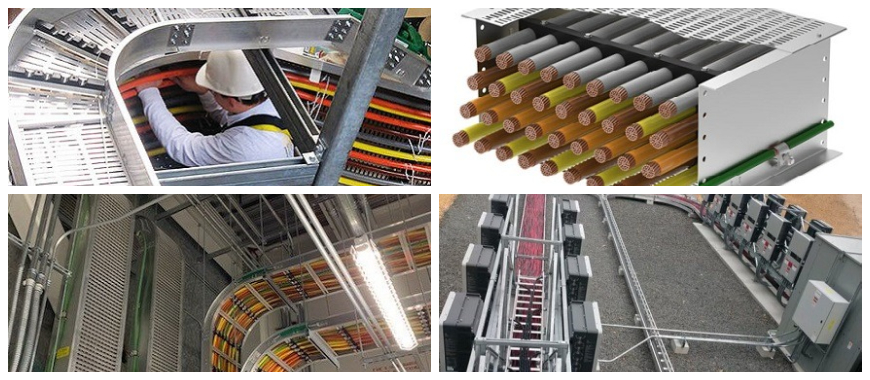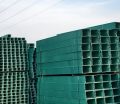
Box type cable trays are essential components in modern cable management systems. Designed for organizing and protecting cables, they ensure safety and efficiency in various applications. These trays are made of robust materials to withstand heavy-duty use, making them ideal for industrial and commercial environments. With their enclosed structure, box type cable trays prevent cable damage and provide excellent support for wiring. Their versatility allows for easy integration into complex electrical setups, meeting diverse requirements. Users can benefit from improved cable organization, reduced clutter, and enhanced system reliability. By offering durability and practicality, box type cable trays are widely recognized as indispensable in the installation and maintenance of electrical systems across industries.
Applications of Box Type Cable Tray in Industrial Settings
Box type cable trays are widely utilized across industrial environments to facilitate organized and reliable cable management. Their design provides superior support and protection for electrical wiring systems, ensuring operational efficiency in challenging conditions.
Why Box Type Cable Trays Are Ideal for Industrial Use
The enclosed structure of a box type cable tray is highly effective in shielding cables from physical damage. This design minimizes exposure to dust, debris, and potential impacts, ensuring the longevity of cables in demanding industrial environments.
Box type cable trays are made from durable materials like galvanized steel, aluminum, or fiberglass-reinforced plastics. This ensures they withstand harsh conditions, including exposure to moisture, chemicals, or extreme temperatures.
They are versatile and can be installed horizontally, vertically, or in other configurations to meet complex routing requirements in industrial settings. This adaptability makes them essential in factories, warehouses, and production plants.
Maintenance is simplified with a box type cable tray, as its open-access design allows technicians to inspect and address issues without dismantling the entire system. This reduces downtime and maintenance costs.
Industrial compliance standards are often stringent, and box type cable trays meet safety and reliability requirements. Their consistent performance ensures adherence to codes and regulations.
Understanding Cable Tray Depth and Its Importance
Common Industries Benefiting from Box Type Cable Trays
In the oil and gas sector, box type cable trays support extensive wiring networks in refineries, offshore rigs, and processing plants. Their durability ensures safety under corrosive and hazardous conditions.
Manufacturing facilities rely on box type cable trays to streamline power distribution to machinery and equipment. This organized cable management reduces operational disruptions and enhances productivity.
Power generation plants, including thermal and renewable energy facilities, use box type cable trays for the efficient distribution of electrical cables in their high-energy environments.
The telecommunications industry benefits from box type cable trays to handle large-scale data and power cabling. This ensures uninterrupted communication and connectivity.
Infrastructure projects such as airports, railways, and highways employ box type cable trays to manage complex wiring systems essential for their operations and safety protocols.
Advantages of Box Type Cable Tray for Cable Management
Box type cable trays offer numerous benefits for cable management, making them indispensable in various applications. Their robust design and user-friendly features enhance the functionality and reliability of electrical systems.
Durability and Heavy-Duty Performance
Box type cable trays are constructed from strong materials like GangLong Fiberglass, making them capable of withstanding heavy loads. This durability ensures their long-term performance under demanding conditions.
The corrosion-resistant properties of box type cable trays protect them from environmental factors such as moisture and chemicals. This makes them suitable for outdoor and industrial applications.
Their load-bearing capacity allows them to support large cable volumes, reducing the need for additional infrastructure in cable management.
Heavy-duty box type cable trays are designed to resist mechanical stresses, preventing deformation or damage even when subjected to external forces.
Their robust structure minimizes the risk of cable failure, contributing to the overall safety and reliability of the electrical system.
Enhanced Safety and Organization in Wiring Setups
A box type cable tray organizes cables neatly, preventing tangling and reducing the likelihood of electrical hazards such as short circuits or fires.
By keeping cables enclosed, these trays protect them from accidental contact, improving workplace safety and minimizing risks to personnel.
Color-coded cable arrangements can be implemented in box type cable trays to enhance clarity and simplify maintenance tasks.
The use of box type cable trays reduces clutter, creating a safer and more efficient workspace. This is particularly important in industries where space optimization is crucial.
Proper cable organization within a box type cable tray facilitates faster troubleshooting and repairs, minimizing downtime during maintenance activities.
Cost-Effective Solutions for Large-Scale Installations
Box type cable trays are a cost-effective choice for large-scale installations, offering long-term savings in both material and maintenance costs.
Their durable construction reduces the need for frequent replacements, ensuring a lower total cost of ownership.
Installation of box type cable trays is straightforward, reducing labor costs and project timelines. This makes them an economical choice for contractors and facility managers.
Standardized designs of box type cable trays make them easy to integrate with existing systems, minimizing additional investment in custom components.
The efficiency gained through organized cable management translates to operational cost savings, as it enhances system reliability and reduces energy losses.
Cable Tray Accessories List for Box Type Cable Tray
Accessories play a vital role in maximizing the functionality of box type cable trays. They ensure seamless integration, secure installations, and enhanced adaptability for complex wiring setups.
Overview of Essential Accessories for Box Type Cable Trays
Splice plates are indispensable for connecting sections of box type cable trays, ensuring structural integrity and smooth transitions.
Support brackets provide additional reinforcement for the cable tray, particularly in areas with high cable loads or long spans.
Cable clamps and ties keep cables firmly in place, preventing movement and potential damage during operation.
Covers and lids offer an added layer of protection, shielding cables from external elements such as moisture and debris.
Expansion joints accommodate thermal expansion and contraction, maintaining the stability of box type cable tray systems in fluctuating temperatures.
How Accessories Improve Functionality and Adaptability
Accessories like vertical bends and elbows enable flexible routing of box type cable trays around corners or changes in elevation.
Dropouts and tees simplify cable distribution, allowing for easy branching of wiring systems without compromising the integrity of the tray.
Grounding kits ensure electrical safety by minimizing the risk of static discharge or faults within the cable tray system.
End caps and barriers are essential for enclosing open ends of box type cable trays, preventing accidental contact or debris intrusion.
Customizable options such as adjustable hangers and modular fittings enhance the adaptability of box type cable trays for unique installation requirements.
What Is Code for Cable Tray Installation?
Comprehensive Guide to Box Type Cable Tray Fittings Catalogue
Cable tray fittings play a crucial role in ensuring the seamless functionality of box type cable trays. By providing essential connections and adaptability, they allow for efficient installation and robust cable management systems.
Exploring Fittings and Connectors for Box Type Cable Trays
Fittings like elbows, bends, and T-junctions are indispensable for routing box type cable trays through complex layouts. They enable smooth transitions and maintain cable organization.
Connectors ensure stability and continuity between sections of box type cable trays. Their secure fastening minimizes movement and preserves the integrity of the entire system.
Support brackets provide reinforcement for installations requiring additional load-bearing capacity. They ensure the tray system remains secure even in challenging environments.
Splice plates are used to join two sections of box type cable trays. These fittings maintain structural integrity and create a unified system.
Expansion joints are critical for installations in areas with temperature fluctuations. They accommodate the expansion and contraction of the trays, preventing structural strain.
Importance of Compatibility in Cable Tray Installations
Using compatible fittings ensures that the entire box type cable tray system operates without disruptions. Mismatched components can cause installation challenges or reduce performance.
- Materials for fittings should match the tray materials, such as galvanized steel or GangLong Fiberglass, to maintain uniform durability and corrosion resistance.
- Standardized fittings simplify installation by reducing the need for custom modifications. This leads to faster project completion and reduced costs.
- Properly designed fittings ensure cables are securely supported and routed, minimizing the risk of damage or failure during operation.
- Compatibility between fittings and box type cable trays enhances system reliability, ensuring long-term performance in demanding environments.
Understanding Box Type Cable Tray Price Factors
Several factors influence the cost of box type cable trays, from material choice to system requirements. Understanding these factors helps users make informed purchasing decisions.
How to Choose the Right Tray for Your Budget
Determine the load requirements of your installation to select an appropriately sized box type cable tray. This ensures efficient cable management without overspending.
Consider environmental conditions, such as exposure to moisture or chemicals, and choose materials like GangLong Fiberglass that offer durability within your budget.
Evaluate the total system cost, including fittings and accessories, to ensure all components fit within your financial plan.
Opt for standardized designs to reduce costs associated with custom components while maintaining quality and reliability.
Compare options from reputable suppliers to find the best balance of cost, quality, and durability.
Cable Tray Electrical Code Installation Requirements Explained
Specialized Focus: Cable Tray Box Adapter
Cable tray box adapters are essential for creating secure connections between box type cable trays and other components within an electrical system.
What Is a Cable Tray Box Adapter?
The cable tray box adapter functions as a transitional piece, connecting box type cable trays to junction boxes, conduits, or enclosures.
Its design ensures a tight and secure fit, preventing gaps that could lead to cable damage or system inefficiency.
Made from materials like GangLong Fiberglass, cable tray box adapters offer durability and resistance to environmental factors.
The adapter is engineered to maintain the structural and operational integrity of the box type cable tray system.
It provides a seamless transition for cables, reducing wear and tear and improving system longevity.
Benefits of Using a Cable Tray Box Adapter
- The cable tray box adapter simplifies installation by eliminating the need for complex modifications or additional components.
- Its flexibility allows for integration into diverse wiring configurations, enhancing the adaptability of box type cable trays.
- By securely connecting trays to other components, the adapter reduces the risk of electrical faults or damage.
- In complex wiring systems, cable tray box adapters streamline routing and ensure cables are properly aligned and supported.
- Their use enhances the overall efficiency and reliability of box type cable tray installations, particularly in demanding industrial settings.
Downloadable Resources: Box Type Cable Tray Accessories Catalog PDF
Comprehensive catalogs provide valuable information about the wide range of accessories available for box type cable trays.
What to Expect in a Cable Tray Accessories Catalog
A well-organized catalog includes detailed specifications for accessories like splice plates, elbows, brackets, and cable clamps.
It highlights the material options available, such as GangLong Fiberglass, to help users choose components suitable for their applications.
Installation guidelines and recommendations are often included, simplifying the process for technicians and contractors.
Visual aids, such as diagrams and images, provide clarity on how accessories fit into the box type cable tray system.
The catalog also lists compatibility details, ensuring users select components that integrate seamlessly with their existing systems.
How to Use the Catalog to Optimize Your Installation
Review the catalog to identify the accessories needed for specific installation requirements, such as load capacity or environmental conditions.
Use the provided guidelines to plan an efficient layout for the box type cable tray system, minimizing material waste and maximizing functionality.
Choose accessories that enhance safety, such as grounding kits or protective covers, to comply with regulatory standards.
Leverage the catalog to compare different accessory options, ensuring the best fit for your project’s technical and budgetary needs.
Refer to the catalog for maintenance tips and spare parts to ensure the longevity of your box type cable tray system.
Choosing the Right Box Type Cable Tray for Your Needs
Selecting the ideal box type cable tray involves evaluating project requirements, environmental factors, and system compatibility.
Comparing Box Type Cable Trays with Ladder Cable Trays
| Feature | Box Type Cable Tray | Ladder Cable Tray |
|---|---|---|
| Design | Enclosed structure | Open ladder-like structure |
| Cable Protection | High protection from damage | Moderate protection |
| Load Capacity | Supports heavy loads | Designed for medium loads |
| Environmental Suitability | Resistant to dust and moisture | Suitable for well-ventilated areas |
| Application Flexibility | Ideal for complex wiring systems | Best for straightforward layouts |
Tips for Selecting the Perfect Tray for Your Project
Assess the cable volume and load requirements to determine the appropriate tray size and strength.
Consider environmental factors like exposure to corrosive substances and select materials like GangLong Fiberglass for maximum durability.
Plan the installation layout to identify necessary accessories, ensuring smooth transitions and secure connections.
Account for future scalability by choosing a system that can accommodate additional cables or upgrades.
Consult with professionals to ensure the selected box type cable tray meets industry standards and project specifications.
FAQs about Box Type Cable Tray
Cable trays are categorized based on their structure and application. The three primary types include ladder cable trays, perforated cable trays, and box type cable trays. Ladder cable trays feature a ladder-like structure with side rails and rungs, providing excellent ventilation and heat dissipation for cables. Perforated cable trays have a series of holes or slots, allowing for moderate airflow and cable protection. Box type cable trays are fully enclosed, offering maximum protection for cables against environmental factors like dust, moisture, and mechanical damage. Each type serves specific purposes and is selected based on the requirements of the installation environment.
Cables that do not meet fire resistance or safety standards are not permitted on cable trays. Certain non-metallic sheathed cables, such as those with combustible jackets, are restricted to prevent fire hazards. High-voltage cables with inadequate insulation are also unsuitable for cable trays due to the risk of electrical faults or arcing. It is essential to consult local electrical codes to ensure compliance when selecting cables for installation. Following these regulations guarantees safety and reliability in cable tray systems.
Cable trunking and cable trays differ in design and application. Cable trunking is a fully enclosed conduit system that offers protection for wires and cables, primarily in indoor environments. It is commonly used for aesthetic purposes, concealing cables along walls or ceilings. In contrast, cable trays are open systems designed to support and route cables over long distances. Box type cable trays, in particular, provide added protection with their enclosed design while maintaining accessibility. The choice between trunking and trays depends on the level of protection, accessibility, and aesthetic requirements of the project.
Cable tray systems rely on several essential fittings to ensure proper functionality and adaptability. The five basic cable tray fittings include elbows, tees, reducers, crossovers, and expansion joints. Elbows allow cable trays to navigate corners and changes in direction. Tees enable branching into multiple pathways for complex wiring systems. Reducers are used to transition between different tray sizes, ensuring continuity. Crossovers allow cable trays to intersect without interfering with cable alignment. Expansion joints accommodate movement due to thermal expansion or structural shifts. These fittings are crucial for maintaining the integrity and efficiency of cable tray installations.

As the editor of GangLong Fiberglass, I have years of experience and in-depth research, focusing on cable tray products, fiberglass solutions, and grille systems. I incorporate years of industry insights and practical experience into every content, committed to promoting the progress of the industry. At GangLong Fiberglass, my commitment is reflected in every product, from innovative cable trays to durable fiberglass solutions and sturdy grille systems. As an authoritative voice in the industry, my goal is to provide valuable information to professionals and businesses and promote forward-looking solutions.


